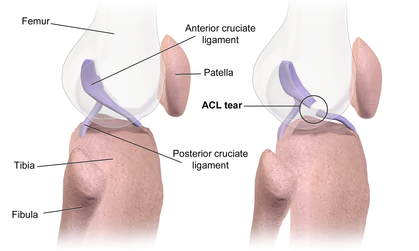Lever Sign Test: Difference between revisions
No edit summary |
No edit summary |
||
| Line 1: | Line 1: | ||
<div class="editorbox"> '''Original Editor '''- [[User:Shwe Shwe U Marma|Shwe Shwe U Marma]] '''Top Contributors''' - {{Special:Contributors/{{FULLPAGENAME}}}}</div> | <div class="editorbox"> '''Original Editor '''- [[User:Shwe Shwe U Marma|Shwe Shwe U Marma]] '''Top Contributors''' - {{Special:Contributors/{{FULLPAGENAME}}}}</div> | ||
== Purpose == | == Purpose == | ||
Lever sign test, also known as Lelli’s test, is a test used to diagnose [[Anterior Cruciate Ligament (ACL) Reconstruction|anterior cruciate ligament]] (ACL) rupture.<ref name=":0">Lelli A, Di Turi RP, Spenciner DB, Dòmini M. [https://link.springer.com/article/10.1007/s00167-014-3490-7 The “Lever Sign”: a new clinical test for the diagnosis of anterior cruciate ligament rupture]. ''Knee Surgery, Sports Traumatology, Arthroscopy''. 2016 Sep 1;24(9):2794-7.</ref> | Lever sign test, also known as Lelli’s test, is a test used to diagnose [[Anterior Cruciate Ligament (ACL) Reconstruction|anterior cruciate ligament]] (ACL) rupture.<ref name=":0">Lelli A, Di Turi RP, Spenciner DB, Dòmini M. [https://link.springer.com/article/10.1007/s00167-014-3490-7 The “Lever Sign”: a new clinical test for the diagnosis of anterior cruciate ligament rupture]. ''Knee Surgery, Sports Traumatology, Arthroscopy''. 2016 Sep 1;24(9):2794-7.</ref>It can be performed after acute injury without producing much discomfort.<ref>Pramod VK, Krishnan J, Shah I. [https://www.researchgate.net/profile/Joji_Krishnan2/publication/341203379_CLINICORADIOLOGICAL_AND_ARTHROSCOPIC_CORRELATION_OF_LEVER_SIGN_TEST_IN_DIAGNOSIS_OF_ISOLATED_ANTERIOR_CRUCIATE_LIGAMENT_RUPTURE/links/5eb3925b45851523bd49906b/CLINICORADIOLOGICAL-AND-ARTHROSCOPIC-CORRELATION-OF-LEVER-SIGN-TEST-IN-DIAGNOSIS-OF-ISOLATED-ANTERIOR-CRUCIATE-LIGAMENT-RUPTURE.pdf Clinicoradiological and arthroscopic correlation of "lever sign test" in diagnosis of isolated anterior cruciate ligament rupture]. ''International Journal of Scientific Research''. 2020;9:1-2.</ref> | ||
[[File:ACL Tear.png|center|419x419px|thumb]] | [[File:ACL Tear.png|center|419x419px|thumb]] | ||
| Line 13: | Line 13: | ||
== Evidence == | == Evidence == | ||
Preliminary results suggest almost 100% sensitivity and specificity of Lelli’s test.<ref name=":0" />However, | Preliminary results suggest almost 100% sensitivity and specificity of Lelli’s test.<ref name=":0" />However, Valsalam et al (2020) found its sensitivity of 85.57%, specificity of 25.00%, PPV of 82.18%, NPV of 30.00%, and accuracy of 73.55%.<ref>Valsalam P, Sha I I, Edwin A. Lever Test: [[Role of Its Assistance in Diagnosis of Anterior Cruciate Ligament Injury]]. ''Journal of Research in Orthopedic Science''. 2020 Aug 10;7(3):115-20.</ref> | ||
{{#ev:youtube|44W5MER9IAA}}<ref>Jessica Keller. Positive Lelli's test! Available from: https://www.youtube.com/watch?v=44W5MER9IAA [last accessed 28 December 2020]</ref> | {{#ev:youtube|44W5MER9IAA}}<ref>Jessica Keller. Positive Lelli's test! Available from: https://www.youtube.com/watch?v=44W5MER9IAA [last accessed 28 December 2020]</ref> | ||
Revision as of 17:36, 2 January 2021
Purpose[edit | edit source]
Lever sign test, also known as Lelli’s test, is a test used to diagnose anterior cruciate ligament (ACL) rupture.[1]It can be performed after acute injury without producing much discomfort.[2]
Technique[edit | edit source]
Patient lies supine with fully extended both legs. One fist of clinician is placed under the proximal third of the calf of one leg. Then, with the other hand, a downward force is applied over distal third of the patient’s quadriceps of same leg.[3]
Interpretation[edit | edit source]
Negative test: When the ACL is intact the downward force applied over the quadriceps will cause the heel to rise.
Positive test: With damaged ACL the downward force will cause anterior translation of tibia in relation to the femoral condyle. So, in this case heel will not rise.[3]
Evidence[edit | edit source]
Preliminary results suggest almost 100% sensitivity and specificity of Lelli’s test.[1]However, Valsalam et al (2020) found its sensitivity of 85.57%, specificity of 25.00%, PPV of 82.18%, NPV of 30.00%, and accuracy of 73.55%.[4]
References[edit | edit source]
- ↑ 1.0 1.1 Lelli A, Di Turi RP, Spenciner DB, Dòmini M. The “Lever Sign”: a new clinical test for the diagnosis of anterior cruciate ligament rupture. Knee Surgery, Sports Traumatology, Arthroscopy. 2016 Sep 1;24(9):2794-7.
- ↑ Pramod VK, Krishnan J, Shah I. Clinicoradiological and arthroscopic correlation of "lever sign test" in diagnosis of isolated anterior cruciate ligament rupture. International Journal of Scientific Research. 2020;9:1-2.
- ↑ 3.0 3.1 Deveci A, Cankaya D, Yilmaz S, Özdemir G, Arslantaş E, Bozkurt M. The arthroscopical and radiological corelation of lever sign test for the diagnosis of anterior cruciate ligament rupture. Springerplus. 2015 Dec 1;4(1):830.
- ↑ Valsalam P, Sha I I, Edwin A. Lever Test: Role of Its Assistance in Diagnosis of Anterior Cruciate Ligament Injury. Journal of Research in Orthopedic Science. 2020 Aug 10;7(3):115-20.
- ↑ Jessica Keller. Positive Lelli's test! Available from: https://www.youtube.com/watch?v=44W5MER9IAA [last accessed 28 December 2020]







